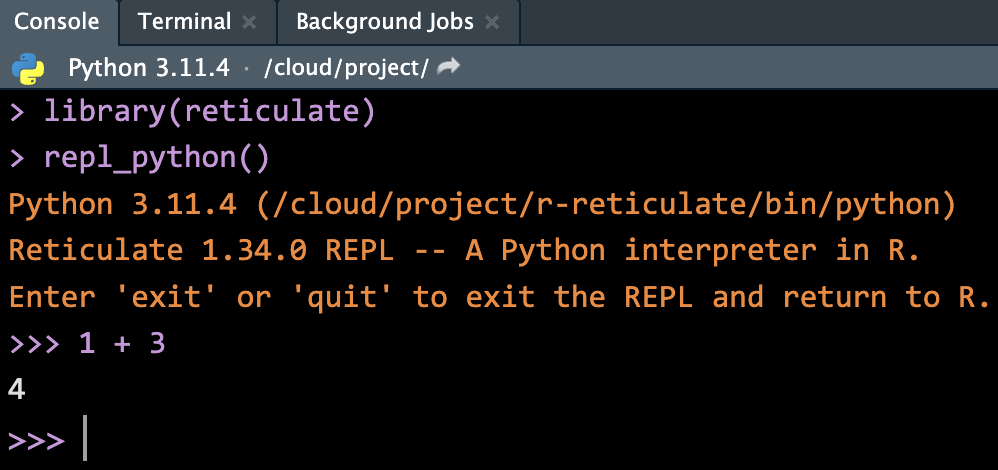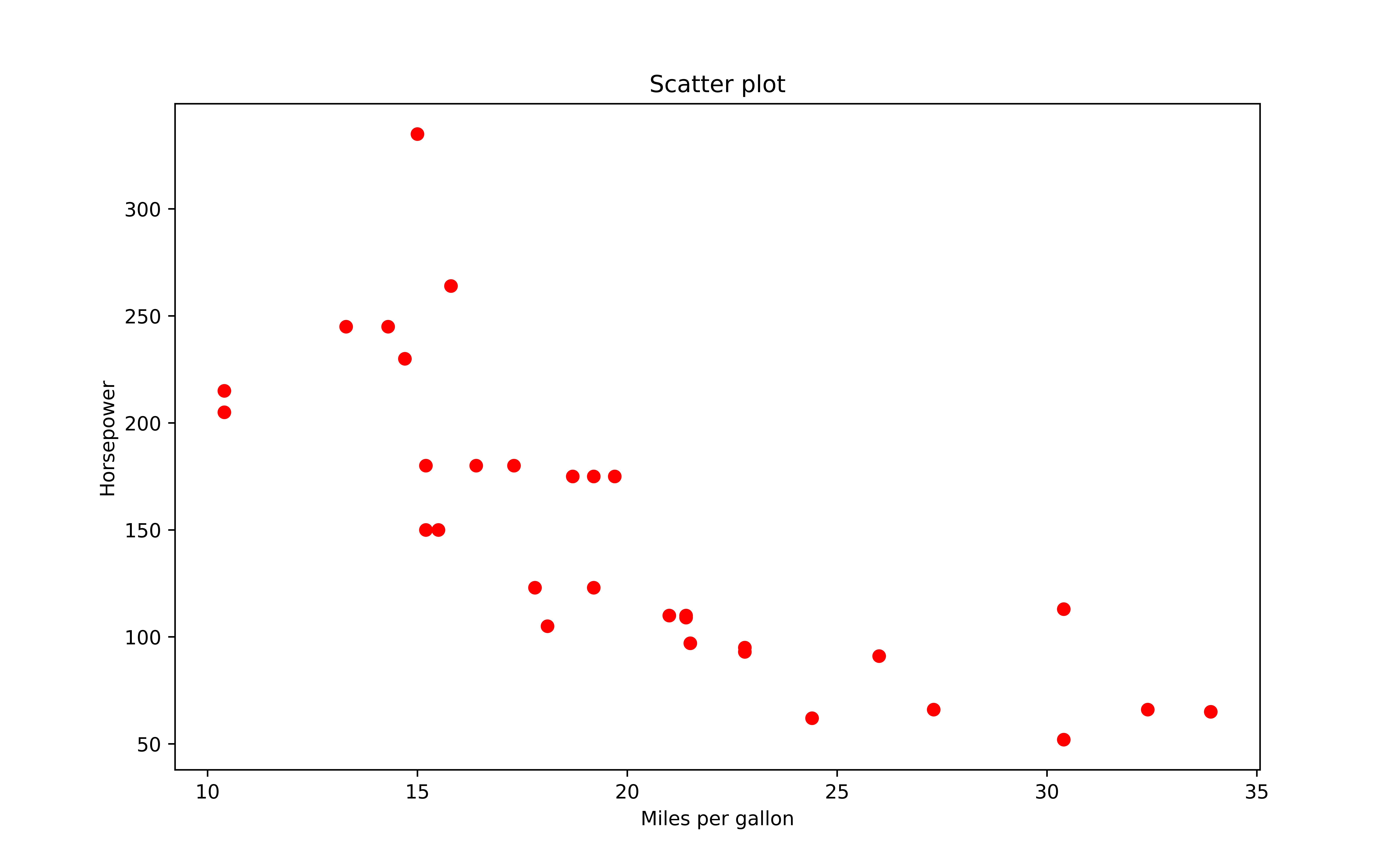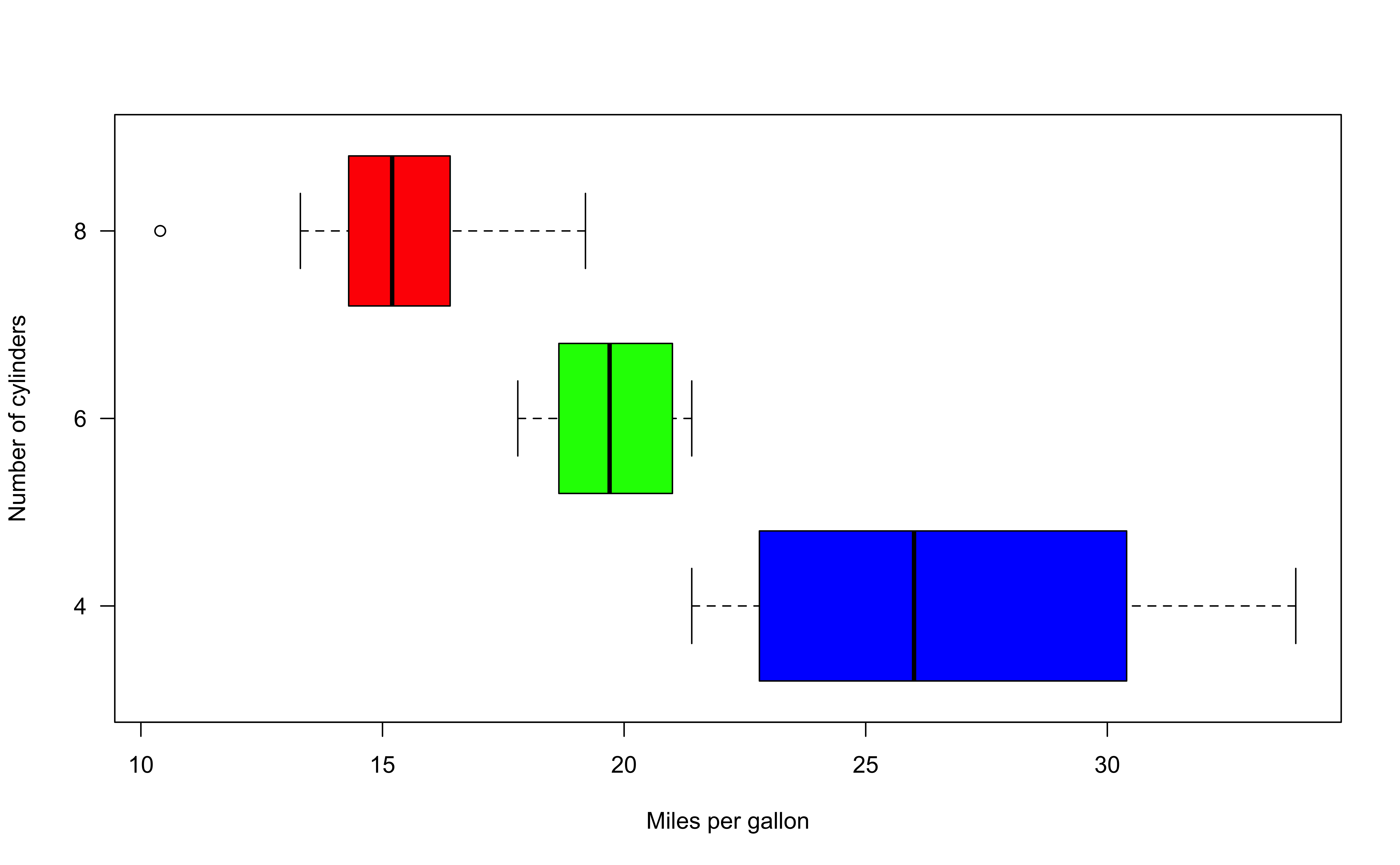
Basic R and Python
MATH/COSC 3570 Introduction to Data Science
Department of Mathematical and Statistical Sciences
Marquette University
Run Code in Console
-
quitorexitto switch back to R.
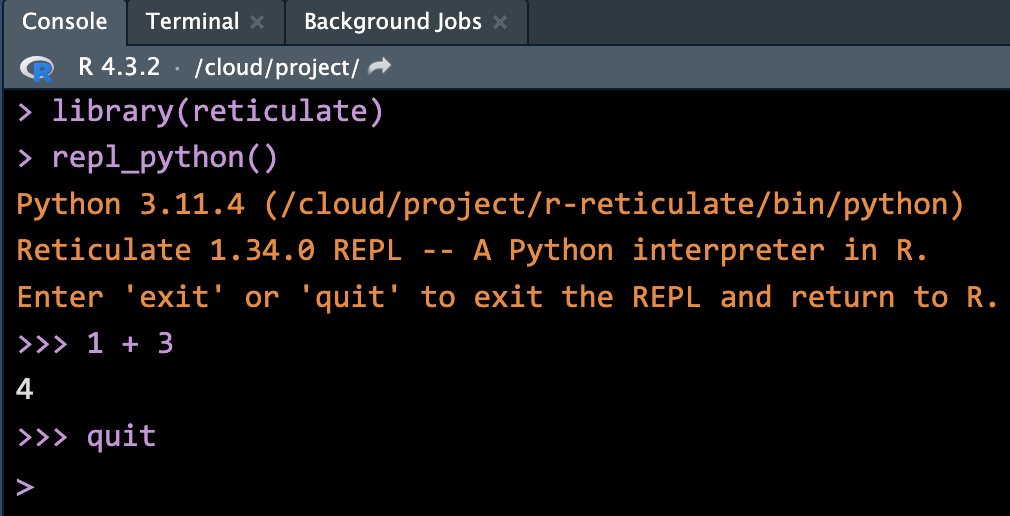
Arithmetic and Logical Operators

2 + 3 / (5 * 4) ^ 2[1] 2.015 == 5.00[1] TRUE# 5 and 5L are of the same value too
# 5 is of type double; 5L is integer
5 == 5L[1] TRUEtypeof(5L)[1] "integer"!TRUE == FALSE[1] TRUEArithmetic and Logical Operators
Math Functions

Math functions in R are built-in.
# R comment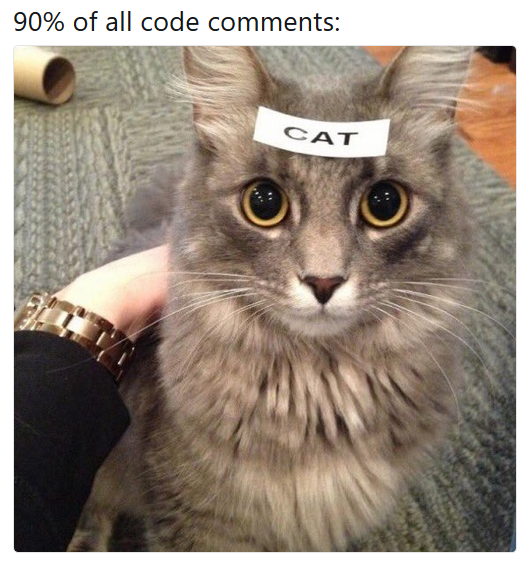

Variables and Assignment
Object Types
R Data Structures
Vector
Factor
List
Matrix
Data Frame


- Variable defined previously is a scalar value, or in fact a (atomic) vector of length one.
(Atomic) Vector
- To create a vector, use
c(), short for concatenate or combine. - All elements of a vector must be of the same type.
Sequence of Numbers
- Use
:to create a sequence of integers. - Use
seq()to create a sequence of numbers of typedoublewith more options.
Operations on Vectors
- We can do any operations on vectors as we do on a scalar variable (vector of length 1).
Recycling of Vectors
- If we apply arithmetic operations to two vectors of unequal length, the elements of the shorter vector will be recycled to complete the operations.
Subsetting Vectors
- To extract element(s) in a vector, we use a pair of brackets
[]with element indexing. - The indexing starts with 1.
Factor
- A vector of type
factorcan be ordered in a meaningful way. Create a factor byfactor().
## Create a factor from a character vector using function factor()
(fac <- factor(c("med", "high", "low")))[1] med high low
Levels: high low med- It is a type of integer, not character. 😲 🙄
List (Generic Vectors)

Lists are different from (atomic) vectors: Elements can be of any type, including lists.
Construct a list by using
list().
Subsetting a List
Return an element of a list
## subset by name (a vector)
x_lst$idx [1] 1 2 3## subset by indexing (a vector)
x_lst[[1]] [1] 1 2 3typeof(x_lst$idx)[1] "integer"
Return a sub-list of a list
## subset by name (still a list)
x_lst["idx"] $idx
[1] 1 2 3## subset by indexing (still a list)
x_lst[1] $idx
[1] 1 2 3typeof(x_lst["idx"])[1] "list"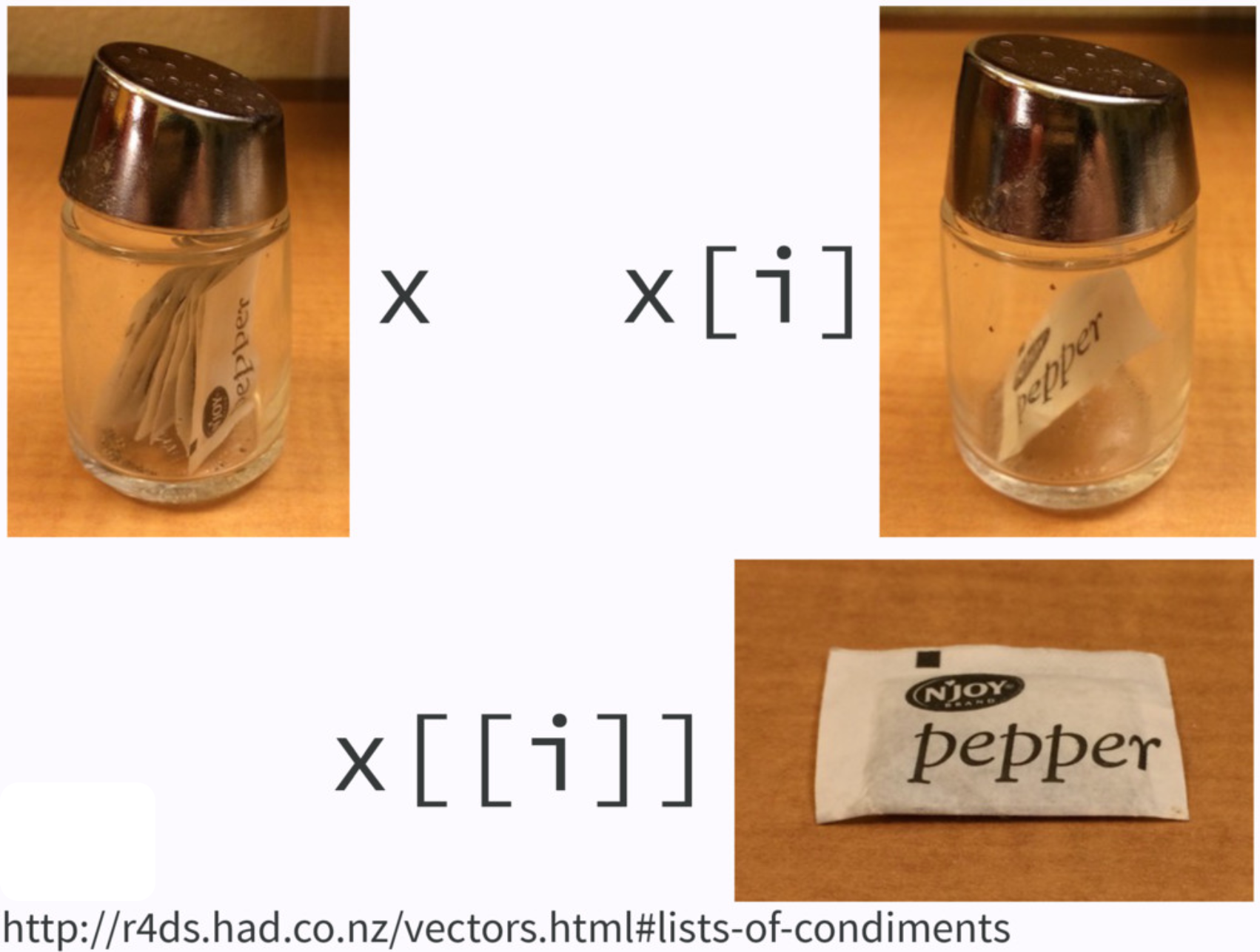
If list
xis a train carrying objects, thenx[[5]]is the object in car 5;x[4:6]is a train of cars 4-6.— @RLangTip, https://twitter.com/RLangTip/status/268375867468681216


Matrix
- A matrix is a two-dimensional analog of a vector with attribute
dim. - Use command
matrix()to create a matrix.
Subsetting a Matrix
- Use the same indexing approach as vectors on rows and columns.
- Use comma
,to separate row and column index. -
mat[2, 2]extracts the element of the second row and second column.
mat [,1] [,2]
[1,] 1 4
[2,] 2 5
[3,] 3 6## all rows and 2nd column
## leave row index blank
## specify 2 in coln index
mat[, 2][1] 4 5 6## 2nd row and all columns
mat[2, ] [1] 2 5## The 1st and 3rd rows and the 1st column
mat[c(1, 3), 1] [1] 1 3Binding Matrices
cbind()(binding matrices by adding columns)rbind()(binding matrices by adding rows)When matrices are combined by columns (rows), they should have the same number of rows (columns).
Data Frame: The Most Common Way of Storing Datasets
- A data frame is of type list of equal-length vectors, having a 2-dimensional structure.
- More general than matrix: Different columns can have different types.
- Use
data.frame()that takes named vectors as input “element”.
## data frame w/ an dbl column named age
## and char column named gender.
(df <- data.frame(age = c(19, 21, 40),
gen = c("m", "f", "m"))) age gen
1 19 m
2 21 f
3 40 m## a data frame has a list structure
str(df) 'data.frame': 3 obs. of 2 variables:
$ age: num 19 21 40
$ gen: chr "m" "f" "m"## must set column names
## or they are ugly and non-recognizable
data.frame(c(19, 21, 40), c("m", "f", "m")) c.19..21..40. c..m....f....m..
1 19 m
2 21 f
3 40 mProperties of Data Frames
Data frame has properties of matrix and list.
## rbind() and cbind() can be used on df
df_r <- data.frame(age = 10,
gen = "f")
rbind(df, df_r) age gen
1 19 m
2 21 f
3 40 m
4 10 fdf_c <-
data.frame(col = c("red","blue","gray"))
(df_new <- cbind(df, df_c)) age gen col
1 19 m red
2 21 f blue
3 40 m graySubsetting a Data Frame
Can use either list or matrix subsetting methods.
df_new age gen col
1 19 m red
2 21 f blue
3 40 m gray## Subset rows
df_new[c(1, 3), ] age gen col
1 19 m red
3 40 m gray## select the row where age == 21
df_new[df_new$age == 21, ] age gen col
2 21 f blue05-R Data Type Summary
In lab.qmd Lab 5,
Create R objects vector
v1, factorf2, listl3, matrixm4and data framed5.Check
typeof()andclass()of those objects, and create a list having the output below.
v1 <- __________
f2 <- __________
l3 <- __________
m4 <- __________
d5 <- __________
v <- c(type = typeof(v1), class = class(v1))
f <- c(type = __________, class = _________)
l <- c(type = __________, class = _________)
m <- c(type = __________, class = _________)
d <- c(type = __________, class = _________)
____(vec = v,
______ = ___,
______ = ___,
______ = ___,
______ = ___)Python Data Structures
List
Tuple
Dictionary
Python Lists
- Python has numbers and strings, but no built-in vector structure.
- To create a sequence type of structure, we can use a list that can save several elements in an single object.
- To create a list in Python, we use
[].
Subsetting Lists
- Indexing in Python always starts at 0!
-
0: the 1st element
-
-1: the last element
What does lst[0:1] return? Is it a list?
Lists are Mutable
Lists are changed in place!
List Operations and Methods list.method()
Tuples
Tuples work exactly like lists except they are immutable, i.e., they can’t be changed in place.
To create a tuple, we use
().
Tuples Functions and Methods
Note
Lists have more methods than tuples because lists are more flexible.
Dictionaries
A dictionary consists of key-value pairs.
A dictionary is mutable, i.e., the values can be changed in place and more key-value pairs can be added.
To create a dictionary, we use
{'key': value}.The value can be accessed by the key in the dictionary.
Properties of Dictionaries
- Python will use the last assignment!
Dictionary Methods
{'Name': 'Ivy', 'Age': 9, 'Class': 'Third'}dict_items([('Name', 'Ivy'), ('Age', 9), ('Class', 'Third')])06-Python Data Structure
In lab.qmd Lab 6,
- Create a Python list and dictionary similar to the R list below.
Remember to create Python code chunk
Any issue of this Python chunk?
Commit and Push your work once you are done.
Python Data Structures for Data Science
Installing NumPy and pandas*
In your lab-yourusername project, run
library(reticulate)
virtualenv_create("myenv")Go to Tools > Global Options > Python > Select > Virtual Environments

Installing NumPy and pandas*
You may need to restart R session. Do it, and in the new R session, run
library(reticulate)
py_install(c("numpy", "pandas", "matplotlib"))Descriptive Statistics (MATH 4720)
Central Tendency and Variability
Data Summary
Central Tendency: Mean and Median
Variation

summary(data) Min. 1st Qu. Median Mean 3rd Qu. Max.
3.0 9.8 17.0 55.3 47.5 230.0 Basic Plotting
Scatter Plot
Boxplot
Histogram
Bar Chart
Pie Chart
2D Imaging
3D Plotting
R plot()
mtcars[1:15, 1:4] mpg cyl disp hp
Mazda RX4 21.0 6 160 110
Mazda RX4 Wag 21.0 6 160 110
Datsun 710 22.8 4 108 93
Hornet 4 Drive 21.4 6 258 110
Hornet Sportabout 18.7 8 360 175
Valiant 18.1 6 225 105
Duster 360 14.3 8 360 245
Merc 240D 24.4 4 147 62
Merc 230 22.8 4 141 95
Merc 280 19.2 6 168 123
Merc 280C 17.8 6 168 123
Merc 450SE 16.4 8 276 180
Merc 450SL 17.3 8 276 180
Merc 450SLC 15.2 8 276 180
Cadillac Fleetwood 10.4 8 472 205plot(x = mtcars$mpg, y = mtcars$hp,
xlab = "Miles per gallon",
ylab = "Horsepower",
main = "Scatter plot",
col = "red",
pch = 5, las = 1)
Argument pch

- The defualt is pch = 1
Python matplotlib.pyplot
mpg cyl disp hp
0 21.0 6 160.0 110
1 21.0 6 160.0 110
2 22.8 4 108.0 93
3 21.4 6 258.0 110
4 18.7 8 360.0 175
5 18.1 6 225.0 105
6 14.3 8 360.0 245
7 24.4 4 146.7 62
8 22.8 4 140.8 95
9 19.2 6 167.6 123
10 17.8 6 167.6 123
11 16.4 8 275.8 180
12 17.3 8 275.8 180
13 15.2 8 275.8 180
14 10.4 8 472.0 205R Subplots

Python Subplots
The command
plt.scatter()is used for creating one single plot.If multiple subplots are wanted in one single call, one can use
plt.subplots()
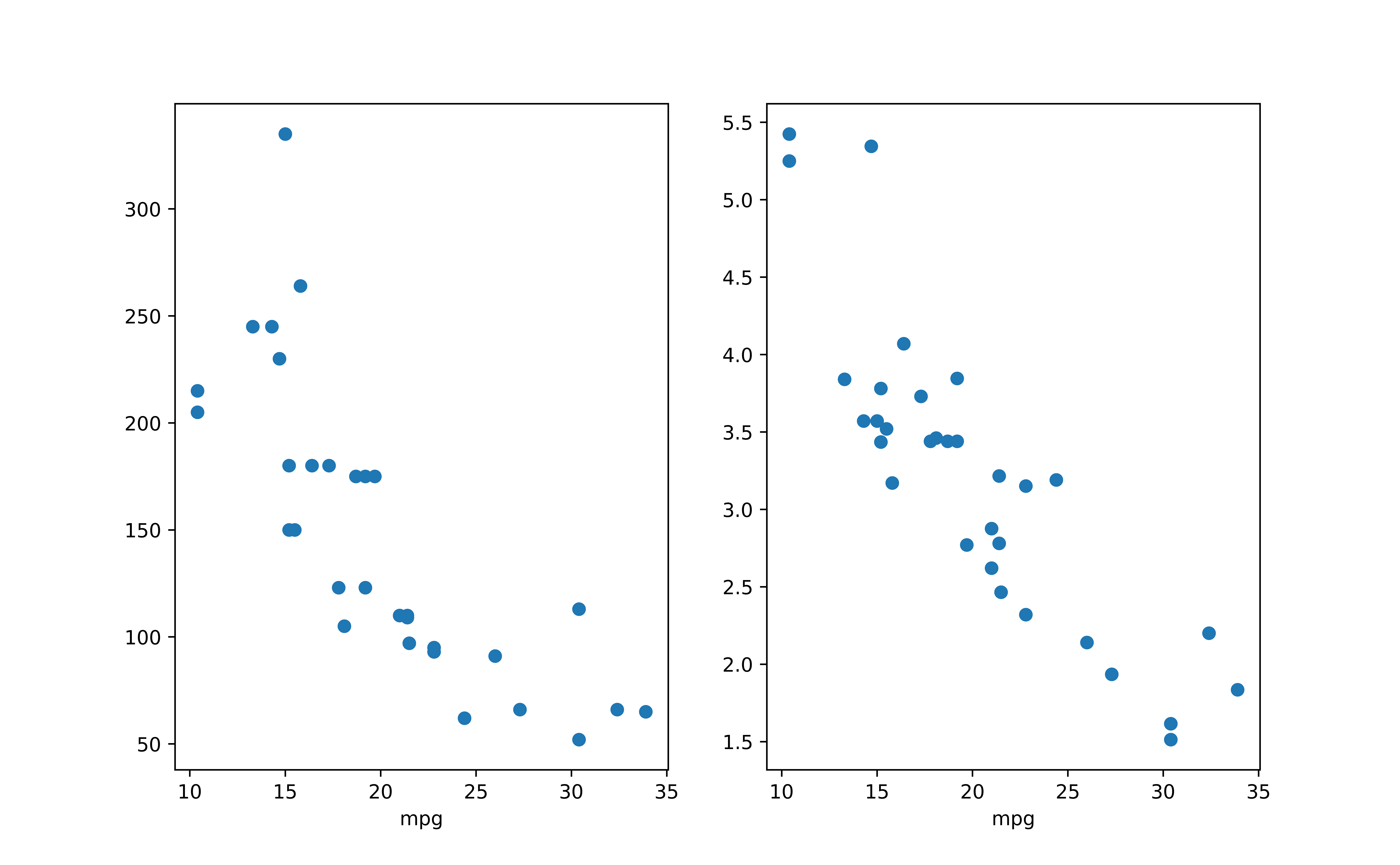
R boxplot()
Python boxplot()

R hist()
-
hist()decides the class intervals/with based onbreaks. If not provided, R chooses one.
hist(mtcars$wt,
breaks = 20,
col = "#003366",
border = "#FFCC00",
xlab = "weights",
main = "Histogram of weights",
las = 1)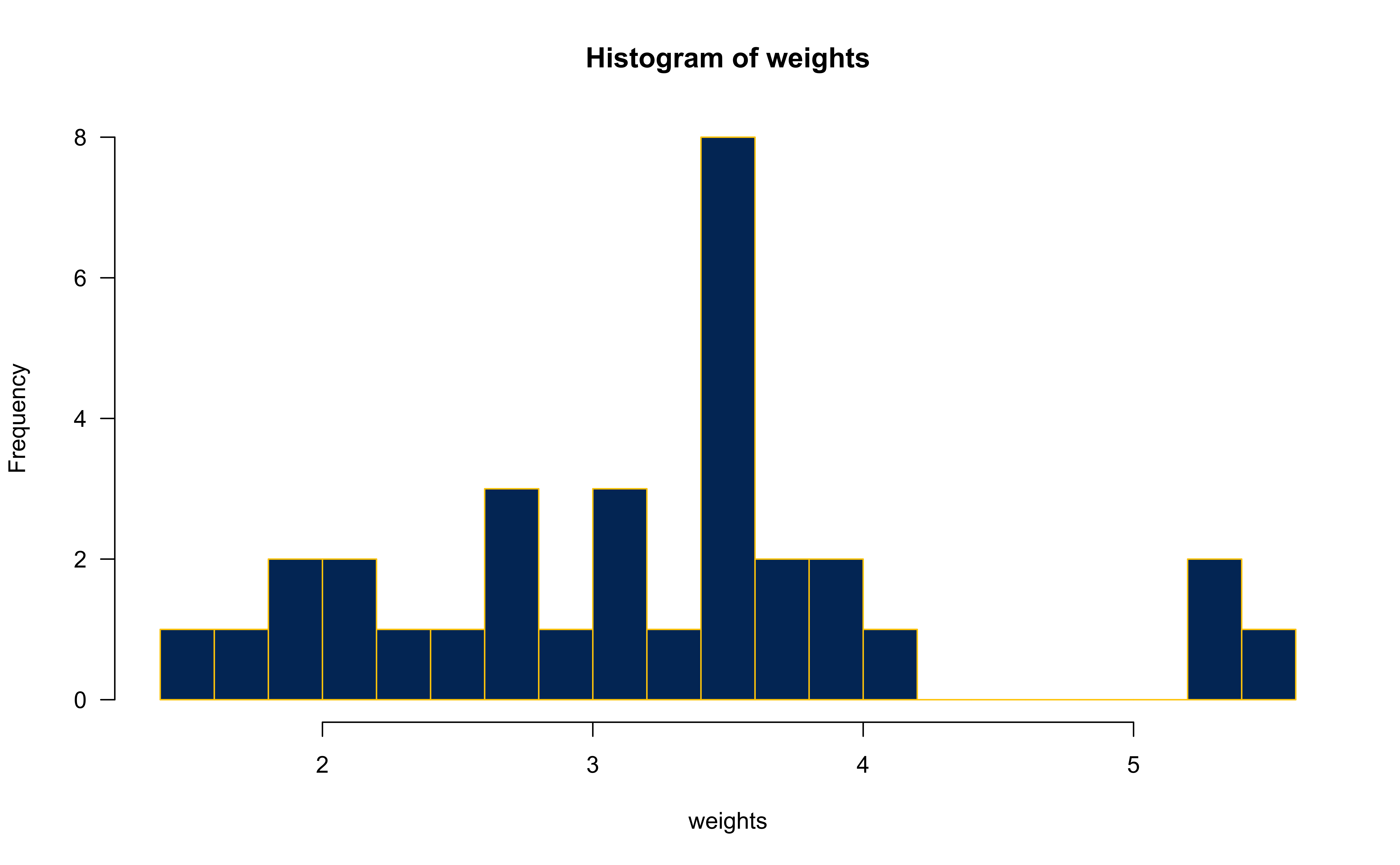
Python hist()
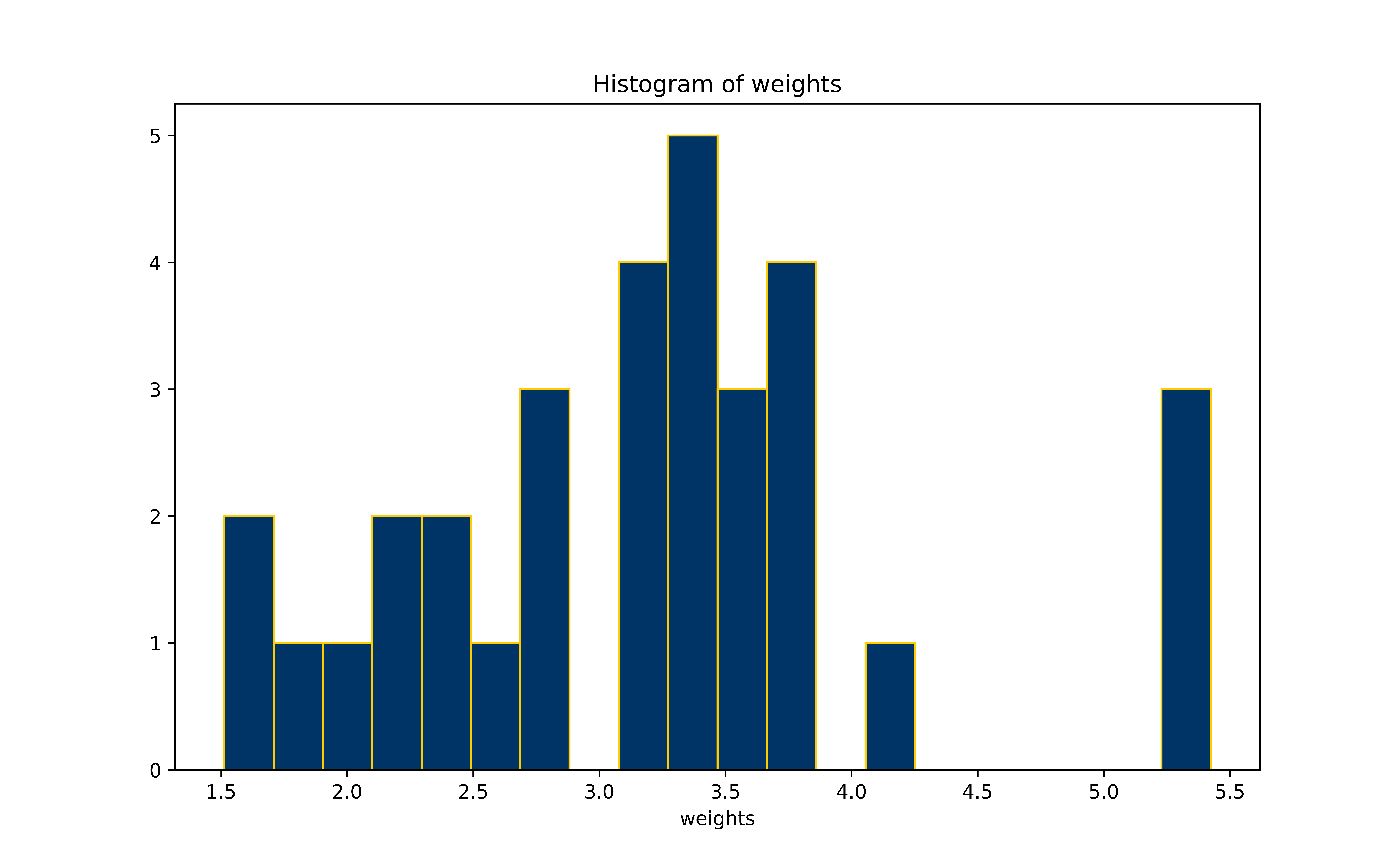
R barplot()
(counts <- table(mtcars$gear))
3 4 5
15 12 5 
Python barplot()
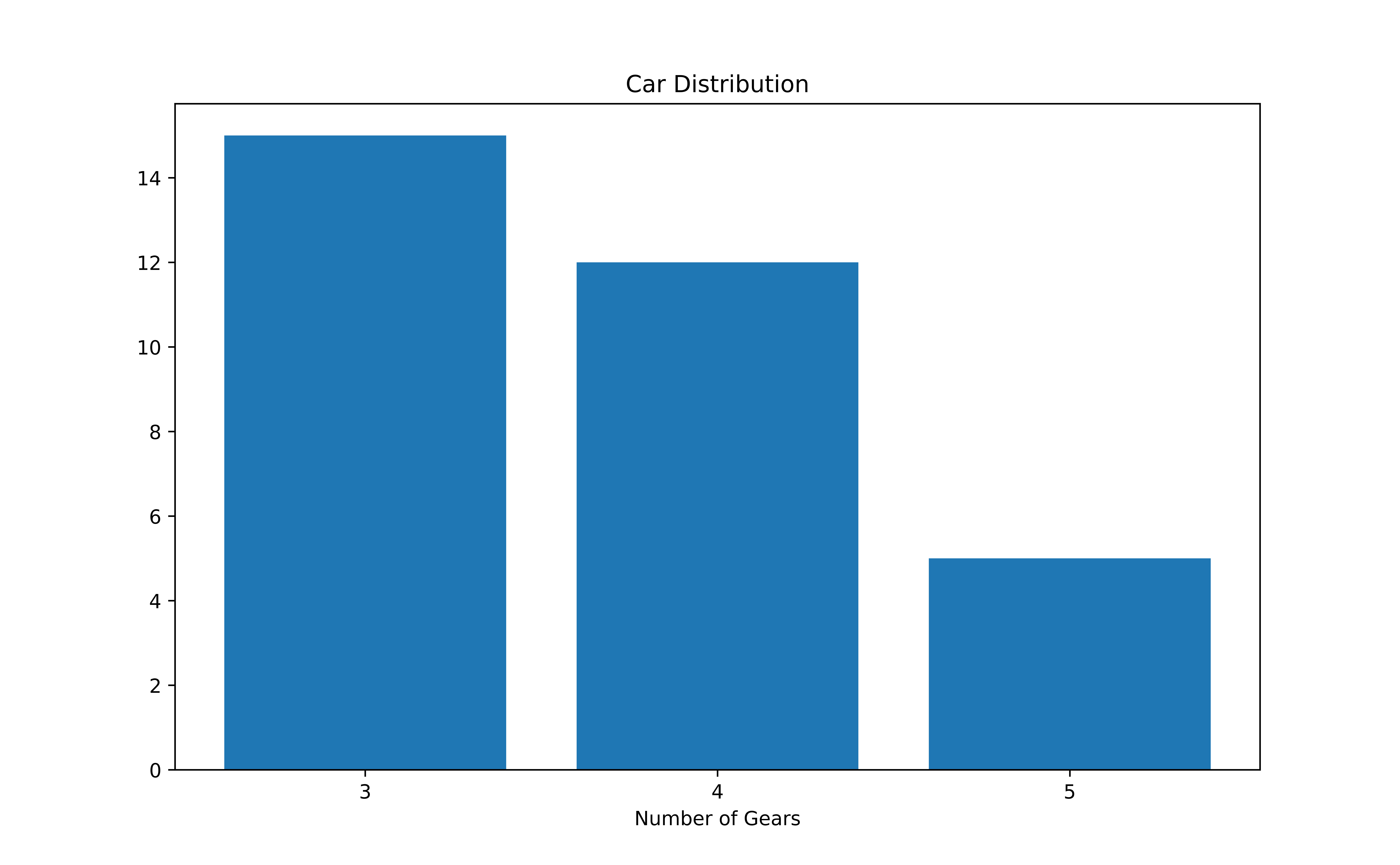
R pie()
3 4 5
46.9 37.5 15.6 (labels <- paste0(3:5, " gears: ", percent, "%"))[1] "3 gears: 46.88%" "4 gears: 37.5%" "5 gears: 15.62%"pie(x = counts, labels = labels,
main = "Pie Chart",
col = 2:4,
radius = 1)
Python pie()
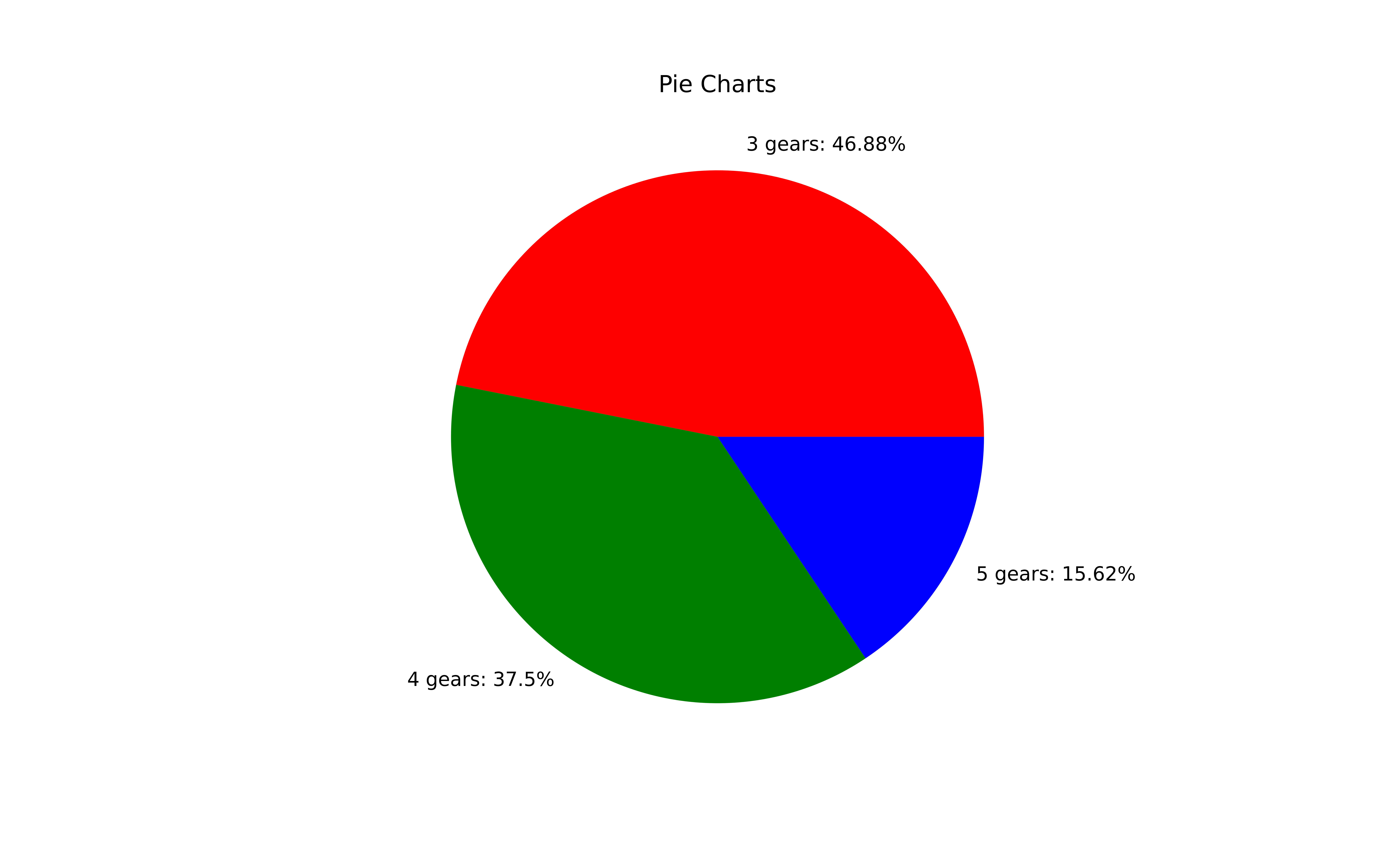
R 2D Imaging: image()
- The
image()function displays the values in a matrix using color.

In Python,
R fields::image.plot()
num [1:87, 1:61] 100 101 102 103 104 105 105 106 107 108 ...image.plot(volcano) num [1:87, 1:61] 100 101 102 103 104 105 105 106 107 108 ...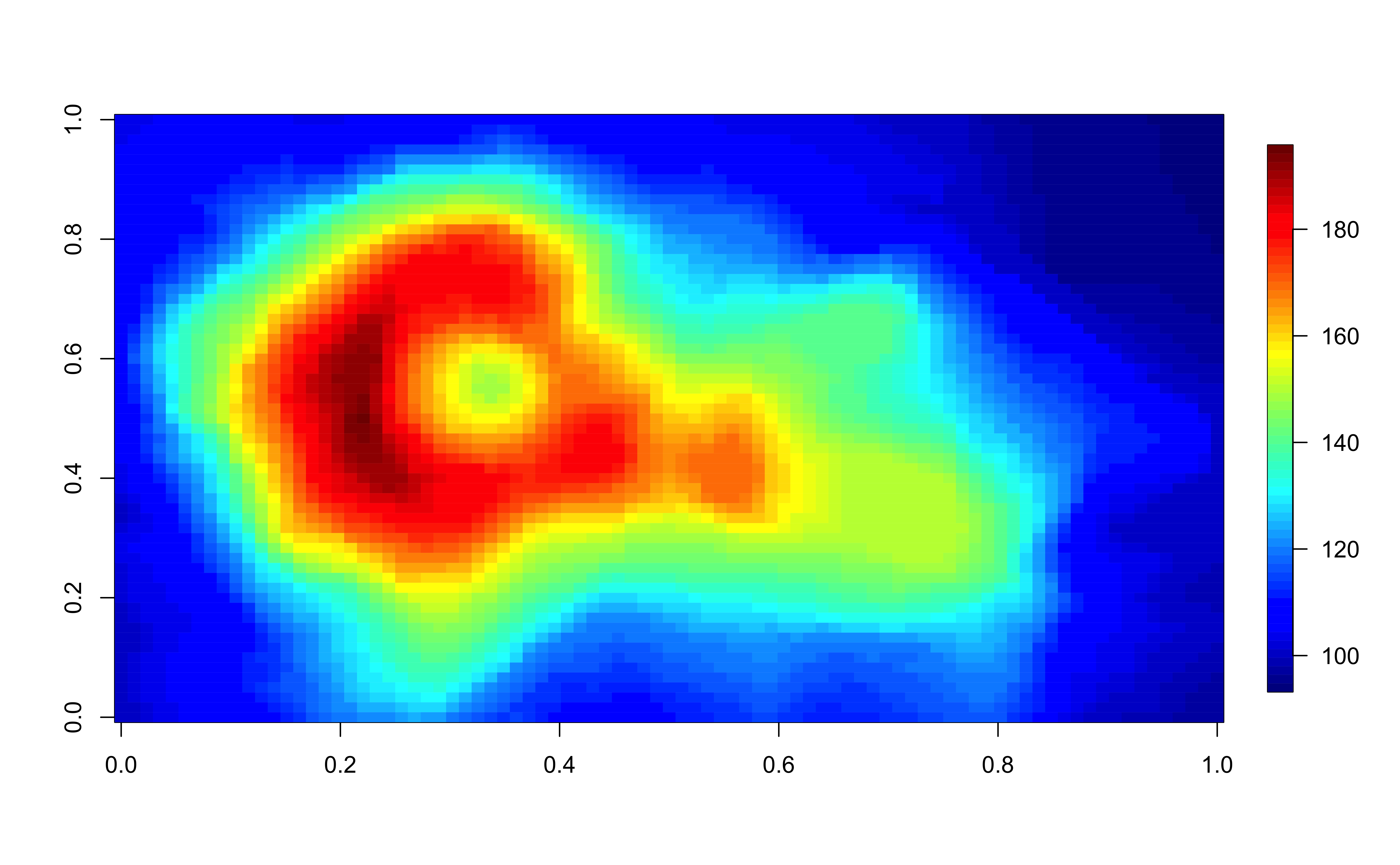
R 2D Imaging Example: Volcano
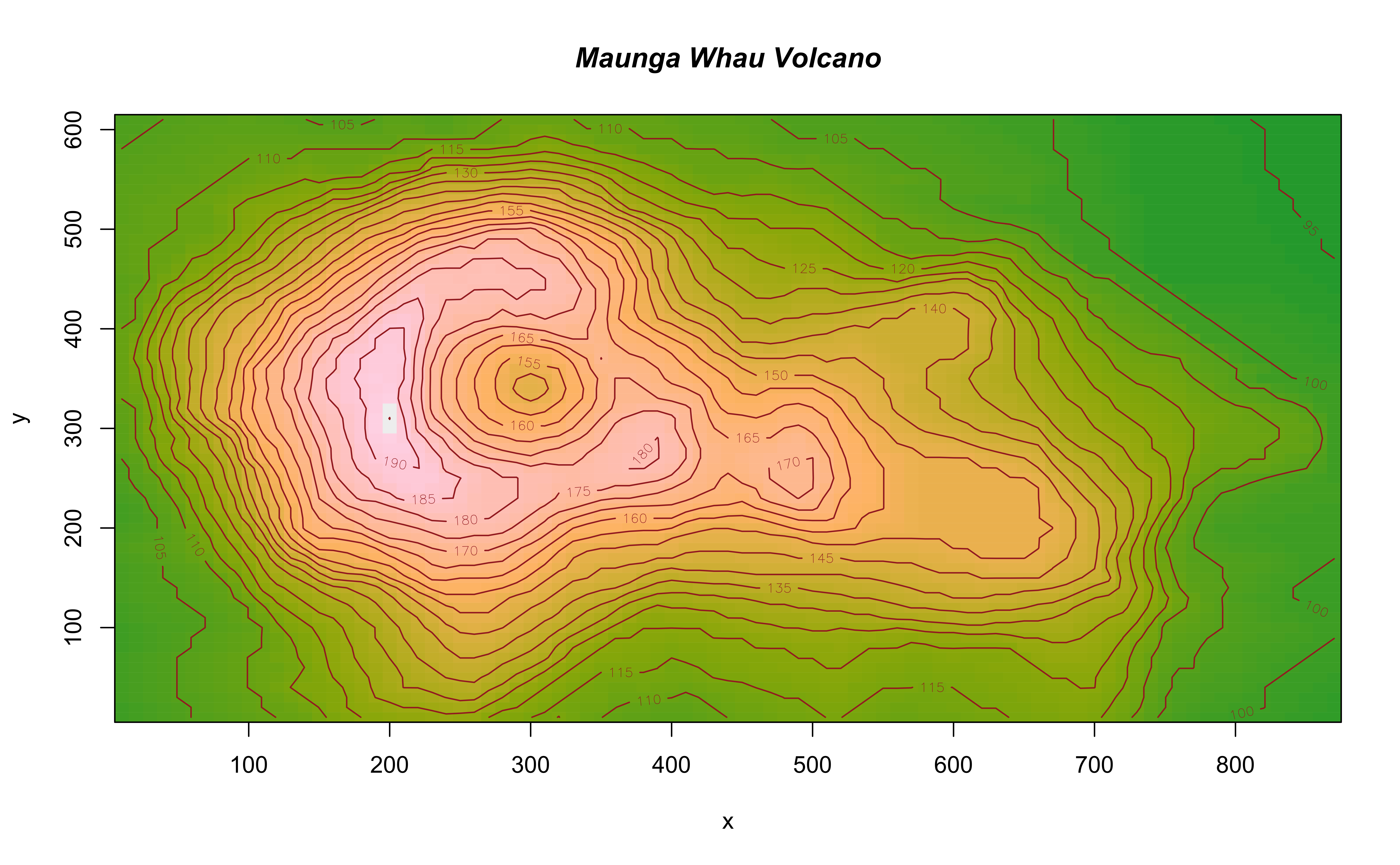
R 3D scatter plot: scatterplot3d()
library(scatterplot3d)
scatterplot3d(x = mtcars$wt,
y = mtcars$disp,
z = mtcars$mpg,
main = "3D Scatter Plot",
xlab = "Weights",
ylab = "Displacement",
zlab = "Miles per gallon",
pch = 16,
color = "steelblue")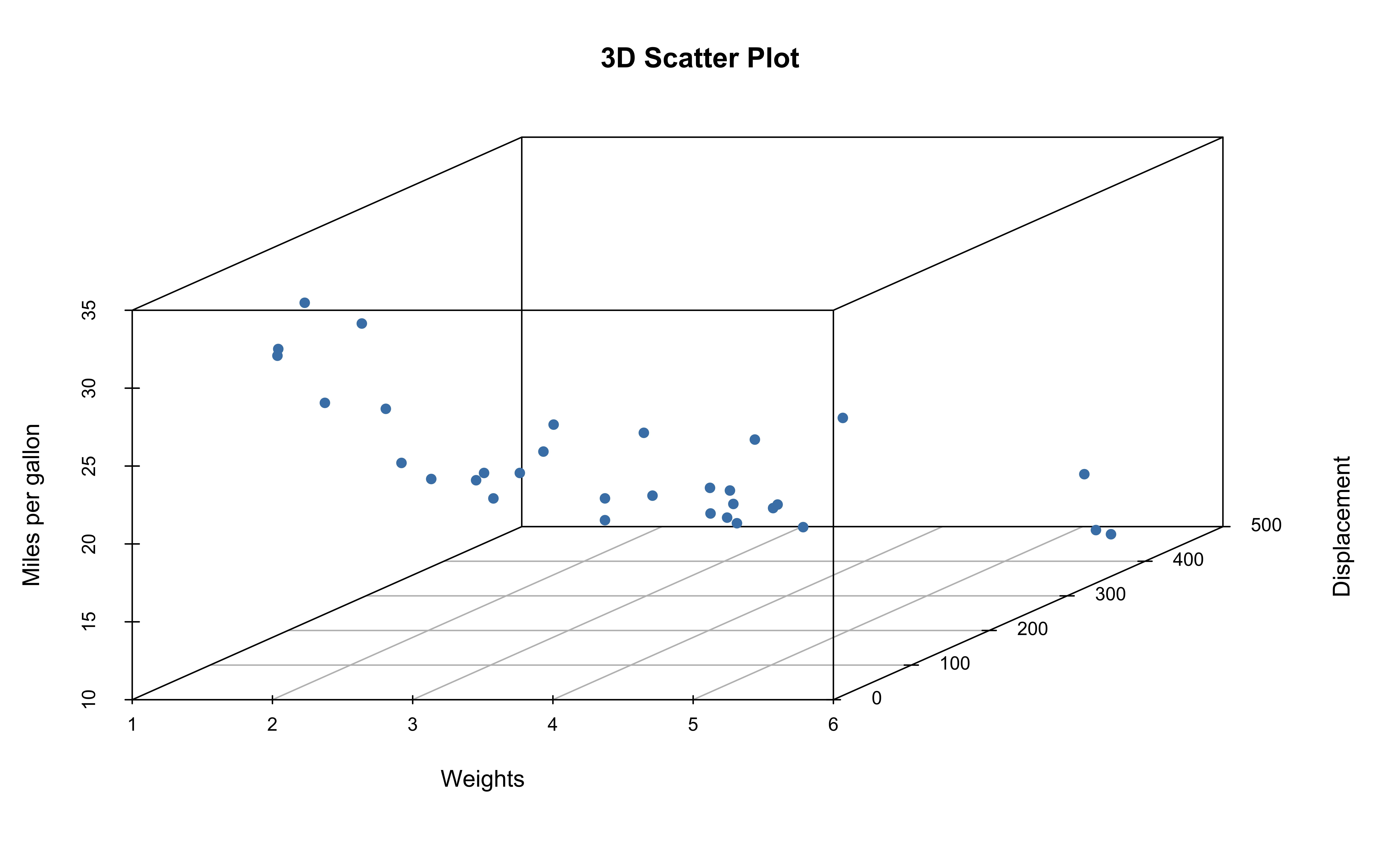
In Python,
R Perspective Plot: persp()
par(mar = c(0,0,0,0))
# Exaggerate the relief
z <- 2 * volcano
# 10 meter spacing (S to N)
x <- 10 * (1:nrow(z))
# 10 meter spacing (E to W)
y <- 10 * (1:ncol(z))
par(bg = "slategray")
persp(x, y, z, theta = 135, phi = 30,
col = "green3", scale = FALSE,
ltheta = -120, shade = 0.75,
border = NA, box = FALSE)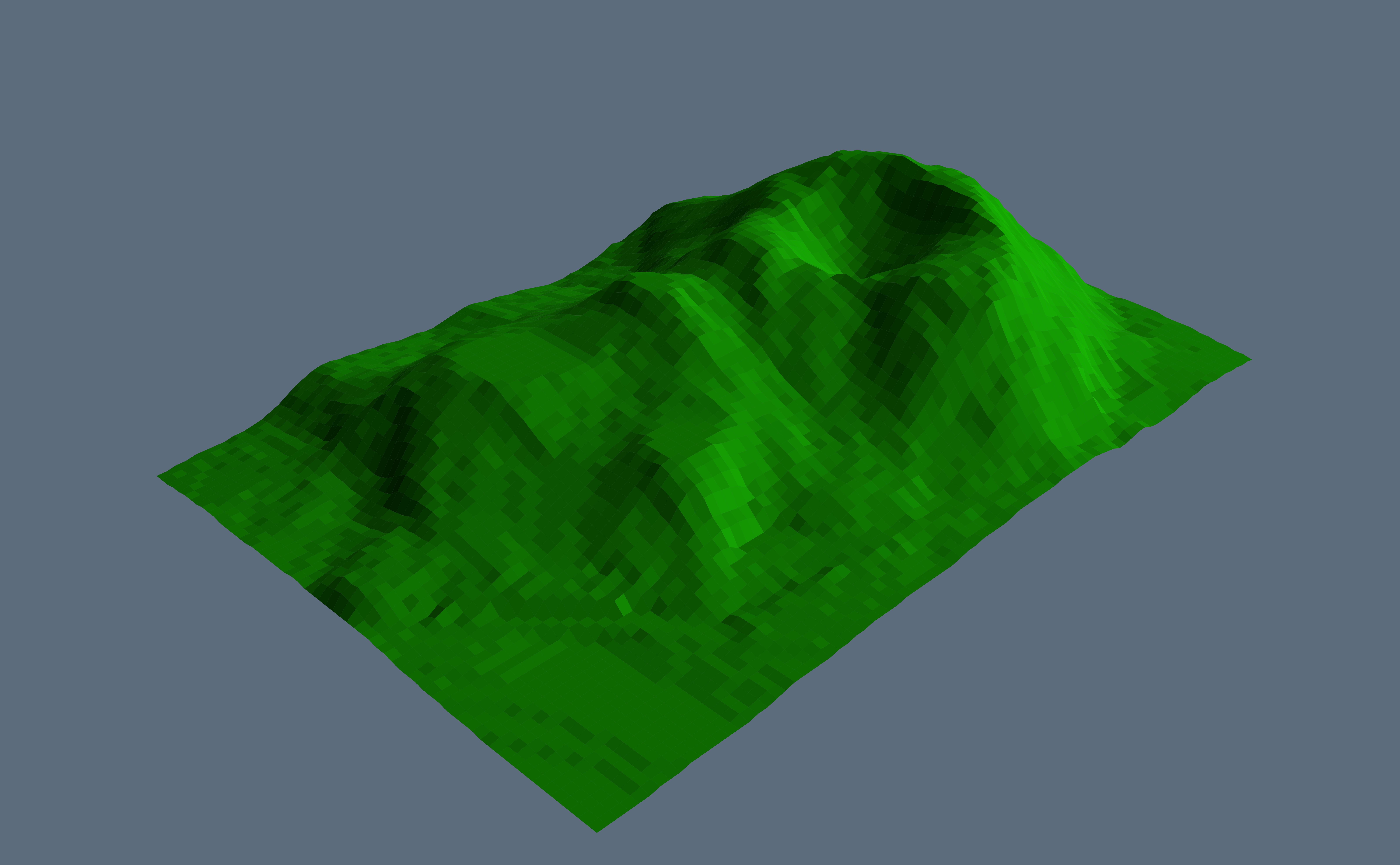
In Python,
Code
volcano = pd.read_csv("./slides/data/volcano.csv", index_col=0)
volcano = volcano.values
z = 2 * volcano
x = np.arange(1, z.shape[0] + 1) * 10
y = np.arange(1, z.shape[1] + 1) * 10
X, Y = np.meshgrid(y, x)
fig = plt.figure()
ax = fig.add_subplot(projection='3d', facecolor="slategray")
ax.plot_surface(X, Y, z, cmap="Greens", edgecolor="none", shade=True, alpha=0.9)
plt.show()07-Plotting
In lab.qmd ## Lab 7,
- For the
mtcarsdata, use R or Python tomake a scatter plot of
miles per gallonvs.weight. Decorate your plot using arguments,col,pch,xlab, etc.create a histogram of 1/4 mile time. Make it beautiful!
- Commit and Push your work once you are done.
Resources
We will talk about data visualization in detail soon!
